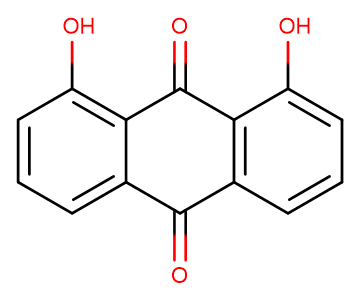
Antrapurol
CAS No. 117-10-2
Antrapurol( Danthron | Chrysazin | Dantron | Antrapurol | Chrysazine )
Catalog No. M10574 CAS No. 117-10-2
Dantron (INN), also known as chrysazin or 1,8-dihydroxyanthraquinone, is used in some countries as a stimulant laxative.
Purity : >98% (HPLC)
 COA
COA
 Datasheet
Datasheet
 HNMR
HNMR
 HPLC
HPLC
 MSDS
MSDS
 Handing Instructions
Handing Instructions
| Size | Price / USD | Stock | Quantity |
| 100MG | 50 | In Stock |


|
| 200MG | Get Quote | In Stock |


|
| 500MG | Get Quote | In Stock |


|
| 1G | Get Quote | In Stock |


|
Biological Information
-
Product NameAntrapurol
-
NoteResearch use only, not for human use.
-
Brief DescriptionDantron (INN), also known as chrysazin or 1,8-dihydroxyanthraquinone, is used in some countries as a stimulant laxative.
-
DescriptionDantron (INN), also known as chrysazin or 1,8-dihydroxyanthraquinone, is used in some countries as a stimulant laxative. Withdrawn from the Canadian, US, and UK markets in 1998 due to genotoxicity. (In Vitro):Danthron (0.1, 1, and 10 μM) dose-dependently promotes the phosphorylation of AMPK and acetyl-CoA carboxylase (ACC) in both HepG2 and C2C12 cells. Meanwhile, Danthron treatment significantly reduces the lipid synthesis related sterol regulatory element-binding protein 1c (SREBP1c) and fatty acid synthetase (FAS) gene expressions, and the total cholesterol (TC) and triglyceride (TG) levels. In addition, Danthron treatment efficiently increases glucose consumption. Danthron effectively reduces intracellular lipid contents and enhances glucose consumption in vitro via activation of AMPK signaling pathway. 10 μM Danthron/24 h is safe for HepG2 cells. With 80% confluence, HepG2 cells are incubated with Danthron (0.1-10 μM) in FBS-Free media for 8 h. Subsequently, cells are harvested for Western blot assay. Danthron increases the p-AMPK protein in a dose-dependent manner, and no changes in t-AMPK protein are observed. Danthron inhibits 9-cis retinoic acid (9cRA)-induced retinoic X receptor α (RXRα) transactivation by IC50 at 0.11 μM. To further clarify the stoichimetric ratio of Danthron binding to RXRα-ligand-binding domain (LBD), isothermal titration calorimetry (ITC) experiment is performed. The KD value of Danthron binds to RXRα-LBD by ITC experiment is determined at 7.5 μM.(In Vivo):Danthron functions as an insulin sensitizer in vivo. Danthron improves insulin sensitivity in diet-induced obese (DIO) mice. The insulin tolerance test result shows that Danthron (5 mg/kg) treated diet-induced obesity mice exhibit lower glucose levels after insulin challenge, compared with the control vehicle-treated group.
-
In VitroDanthron (0.1, 1, and 10 μM) dose-dependently promotes the phosphorylation of AMPK and acetyl-CoA carboxylase (ACC) in both HepG2 and C2C12 cells. Meanwhile, Danthron treatment significantly reduces the lipid synthesis related sterol regulatory element-binding protein 1c (SREBP1c) and fatty acid synthetase (FAS) gene expressions, and the total cholesterol (TC) and triglyceride (TG) levels. In addition, Danthron treatment efficiently increases glucose consumption. Danthron effectively reduces intracellular lipid contents and enhances glucose consumption in vitro via activation of AMPK signaling pathway. 10 μM Danthron/24 h is safe for HepG2 cells. With 80% confluence, HepG2 cells are incubated with Danthron (0.1-10 μM) in FBS-Free media for 8 h. Subsequently, cells are harvested for Western blot assay. Danthron increases the p-AMPK protein in a dose-dependent manner, and no changes in t-AMPK protein are observed. Danthron inhibits 9-cis retinoic acid (9cRA)-induced retinoic X receptor α (RXRα) transactivation by IC50 at 0.11 μM. To further clarify the stoichimetric ratio of Danthron binding to RXRα-ligand-binding domain (LBD), isothermal titration calorimetry (ITC) experiment is performed. The KD value of Danthron binds to RXRα-LBD by ITC experiment is determined at 7.5 μM.
-
In VivoDanthron functions as an insulin sensitizer in vivo. Danthron improves insulin sensitivity in diet-induced obese (DIO) mice. The insulin tolerance test result shows that Danthron (5 mg/kg)treated diet-induced obesity mice exhibit lower glucose levels after insulin challenge, compared with the control vehicle-treated group.
-
SynonymsDanthron | Chrysazin | Dantron | Antrapurol | Chrysazine
-
PathwayMembrane Transporter/Ion Channel
-
TargetAMPK
-
RecptorAMPK
-
Research AreaOther Indications
-
Indication——
Chemical Information
-
CAS Number117-10-2
-
Formula Weight240.22
-
Molecular FormulaC14H8O4
-
Purity>98% (HPLC)
-
SolubilityDMSO: 10 mM
-
SMILESO=C(C1=C2C(O)=CC=C1)C3=CC=CC(O)=C3C2=O
-
Chemical Name1,8-Dihydroxyanthraquinone
Shipping & Storage Information
-
Storage(-20℃)
-
ShippingWith Ice Pack
-
Stability≥ 2 years
Reference
1. Zhou R, et al. Acta Pharmacol Sin. 2013 Aug; 34(8):1061-9.
molnova catalog



related products
-
AMAROGENTIN
Amarogentin is mainly extracted from Swertia and Gentiana roots. It plays cemopreventive/therapeutic role during liver carcinogenesis through modulation of cell cycle and apoptosis
-
PF-739
A novel potent, pan-AMPK activator with similar potency for all AMPK heterotrimers.
-
ZLN 024 hydrochlorid...
ZLN 024 hydrochloride is an AMPK allosteric activator and stimulates the inactive α1 subunit truncations α1 (1-394) and α1 (1-335) but not α1 (1-312).



 Cart
Cart
 sales@molnova.com
sales@molnova.com


